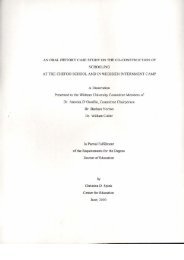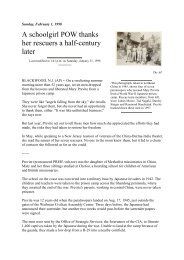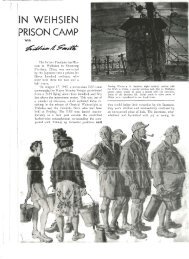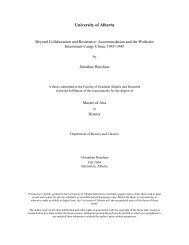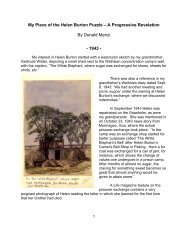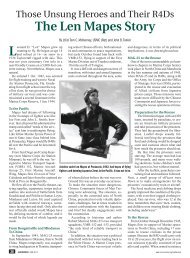Previte's Magnificent Seven - Weihsien-Paintings
Previte's Magnificent Seven - Weihsien-Paintings
Previte's Magnificent Seven - Weihsien-Paintings
- No tags were found...
You also want an ePaper? Increase the reach of your titles
YUMPU automatically turns print PDFs into web optimized ePapers that Google loves.
<strong>Previte's</strong> <strong>Magnificent</strong> <strong>Seven</strong>Schoolgirl liberated from POW camp 52 years ago finally gets to thankrescuersBy Melanie Burney, Associated PresswriterOn a sweltering summer morningmore than 52 years ago, seven mendropped from the heavens andliberated Mary Previte from aJapanese prison camp.They were like "angels falling fromthe sky," she recalls. She never forgotthem, but she never had anopportunity to thank them, either. "Itwas like unfinished business," shesays now.But last year, Previte set out to tell these men how much she appreciated theefforts they had made, the risks they had taken to restore her freedom.In May, while speaking to a New Jersey reunion of veterans of the China-Burma-India theater, she read the names of her seven rescuers. No one in the room knewthem, but it led to a chain of contacts she followed as far as she could.
Previte (pronounced PREH'-vuh-tee) was the daughter of Methodist missionariesin China. Mary and her three siblings studied at Chefoo, a boarding school forchildren of American and British missionaries.The school on the coast was converted into a military base by Japanese invadersin 1942. The children and teachers were taken to the prison camp across theShandong peninsula, where they awaited the end of the war. <strong>Previte's</strong> parents,working in central China, were never taken prisoner.Previte was 12 years old when the paratroopers landed on Aug. 17, 1945, justoutside the gates of the <strong>Weihsien</strong> Civilian Assembly Center. Three days before, theJapanese had announced their surrender, but another two weeks would pass beforethe surrender papers were signed.The men were sent by the Office of Strategic Services, the forerunner of the CIA,to liberate 1,400 captives taken by the Japanese during the war. Unable to land atthe camp because of the guards, they made a low drop from a B-29 into a nearbycornfield.A Salvation Army band began playing "The Star-Spangled Banner" and theprisoners hoisted their rescuers onto their shoulders.Suddenly, unexpectedly, the war was over for them,and they were free."The camp went berserk. We didn't know the warwas over," Previte recalls. "People were dancing,weeping, pounding the ground."Weeks would pass before Mary and her siblingswould be reunited with their parents after a 51/2-yearseparation.They returned to the United States. Mary married,had a daughter, divorced. She taught English, andwent to work as administrator of Camden County'syouth detention center in Blackwood, N.J.She has run the jail since 1974 and says she drawsupon her prison camp experience as she seeks tobring a sense of safety and order to the lives ofjuveniles awaiting trial.Last year, she was chosen president of the NewJersey Juvenile Detention Association and waselected in November to the state Assembly, where she hopes to be an advocate fortroubled youngsters.In 1985, Previte obtained a copy of a declassified military mission report from afellow camp survivor. In it were the names of her rescuers. She tucked it away; itwould be impossible to find them, she thought.On a whim, at the meeting of the veterans group in Mount Laurel, she read thenames. "Never in my wildest dreams did I think I would ever be able to find all ofthese people," says Previte, 65.In October, a notice in the group's newsletter produced the first lead: The widow ofRaymond Hanchulak was living in central Pennsylvania in Bear Creek Village. Herhusband, a medic on the mission, died the previous year.Meanwhile, a man who had been at the May meeting sent Previte pages and
pages of names gleaned from the Internet to check out. The search seemeddaunting: There were more than 150 listings just for James Moore.Then Previte found Peter Orlich's widow, Carol, in the New York City borough ofQueens. Orlich, a radio operator and the youngest of the group, died in 1993 at age70. He, too, had tried to locate the others, unsuccessfully."If he were only alive -- what this would havemeant to him. It's just hard for me to imagine," Mrs.Orlich says.She sent Previte a piece of yellowed silkparachute embroidered with the men's signaturesthat her husband had kept in his dresser drawer."Now I was really heartsick because my first twoconnections were with two widows," Previte says. "Ithought I could not wait one more minute to startcalling every name on this list."'She found Tad Nagaki, a Japanese-Americaninterpreter on the mission. Now 77, he is a recentlywidowed beet farmer in Alliance, Neb. Nagaki sentPrevite photographs his wife kept in a wartimescrapbook.Nagaki told Previte how to find Moore, 78, ofDallas, who attended the same Chefoo missionaryschool before joining the FBI and then the OSS. Helater joined the CIA and retired in 1978.Moore, with help from a neighbor with a national computer database, joined<strong>Previte's</strong> search for the remaining men.He found Stanley Staiger, 79, the mission commander, recovering from a brokenhip at his Nevada home. The last, James Hannon, was located by Moore in YuccaValley, Calif., where he is a writer, drafting plot summaries about the war.Previte ended her search without locating the seventh man, Eddie Wang, theChinese interpreter. The others said he was a Chinese nationalist and they had noidea how to find him.For Previte, it was an immensely gratifying experience."It's never too late to say thank you," Previte says. "It's been like goosebumps upand down my spine to be able to say thank you to these men after 52 years. I toldthem I have so much to be thankful for."She has been getting to know her rescuers and what happened to them after thewar. They were surprised by her interest in their lives."I don't think we made that much of a difference. It could have been anybody,"Moore says, modestly. "It's nice of her to remember us."Staiger was a stockbroker and hotel owner before retiring in Reno. "We did our job,not knowing what would happen when we parachuted in," Staiger says. "We had afew rough moments with the Japanese, but everything worked itself out."Previte would like to organize a reunion of the group, but the men's failing healthmay prevent that. She plans to keep in touch."We were bonded by a war that wrapped us together for so many differentreasons," Previte says. "We've become family now."Photos by The Associated Press
Top: A photograph taken in northeast China in 1945 shows four of the seven paratrooperswho rescued Mary Previte from a World War II Japanese prison camp. Duck Mission Rescueteam members included, from left, James Moore, Tad Nagaki, Stanley Staiger and RaymondHanchulak. Previte finally tracked them down in 1997. Middle: Mary Previte holds theparachute fragment given to her by the widow of one of the paratroopers. Bottom: The photorests on a piece of silk parachute embroidered with details of the mission.



